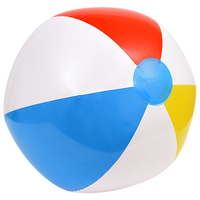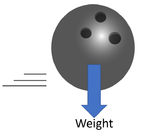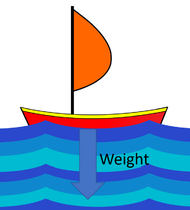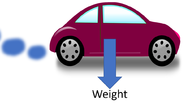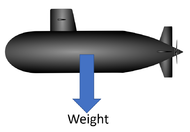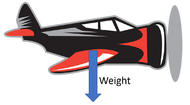Difference between revisions of "Weight"
(Created page with "The force on an object in a gravitational field.") |
|||
| (31 intermediate revisions by 2 users not shown) | |||
| Line 1: | Line 1: | ||
| − | The [[force]] on an [[object]] in a [[Gravitational Field|gravitational field]]. | + | ==Key Stage 2== |
| + | ===Meaning=== | ||
| + | [[Weight]] is how heavy or light something is. | ||
| + | |||
| + | ===About Weight=== | ||
| + | : Objects have [[weight]] because of the [[gravity]] of the [[Earth]]. | ||
| + | : [[Weight]] can be [[Measure|measured]] using a [[Newton Meter]] or a [[Measuring Scale]]. | ||
| + | : [[Weight]] is [[Measure|measured]] in [[Newton]]s but can also be [[Measure|measured]] in [[Stone (Unit)|stone]], [[Pound|pounds]] and [[Ounce|ounces]]. | ||
| + | : [[Weight]] depends on the amount of [[mass]] an [[object]] has. | ||
| + | |||
| + | {| class="wikitable" | ||
| + | | style="height:20px; width:200px; text-align:center;" |Golf Ball | ||
| + | | style="height:20px; width:200px; text-align:center;" |Beach Ball | ||
| + | | style="height:20px; width:200px; text-align:center;" |Bowling Ball | ||
| + | |- | ||
| + | |[[File:Golfball.png|center|200px]] | ||
| + | |[[File:Beachball.png|center|200px]] | ||
| + | |[[File:Bowlingball.png|center|200px]] | ||
| + | |- | ||
| + | | style="height:20px; width:200px; text-align:center;" |The Golf Ball is not made of much [[material]] so it is lightest. | ||
| + | | style="height:20px; width:200px; text-align:center;" |The Beach Ball might be the biggest but it is not the heaviest. | ||
| + | | style="height:20px; width:200px; text-align:center;" |The Bowling Ball is made of the most [[material]], so it is the heaviest. | ||
| + | |} | ||
| + | |||
| + | ==Key Stage 3== | ||
| + | ===Meaning=== | ||
| + | [[Weight]] is the the [[force]] on an [[object]] that is in a [[Gravitational Field|gravitational field]]. | ||
| + | |||
| + | ===About Weight=== | ||
| + | : Weight is a [[force]] so it is [[Measure|measured]] in [[Newton]]s. | ||
| + | : Weight is a [[Non-contact Force|non-contact force]] because an [[object]] does not need to be touching the ground to be [[attract]]ed to the [[Earth]]. | ||
| + | : Weight always acts downwards. | ||
| + | : All [[object]]s on [[Earth]] have [[weight]] because the [[Earth]] has a [[Gravitational Field|gravitational field]]. | ||
| + | : Different [[planet]]s have a different strength [[Gravitational Field|gravitational field]], so the same [[object]] might '''weigh''' a different amount on different [[planet]]s. | ||
| + | : On [[Earth]] the [[Gravitational Field Strength|gravitational field strength]] is roughly 10[[N/kg]] | ||
| + | ===Examples=== | ||
| + | {| class="wikitable" | ||
| + | |- | ||
| + | |[[File:WeightTennisBall.png|center|75px]] | ||
| + | |[[File:WeightBowlingBall.png|center|150px]] | ||
| + | |[[File:WeightBoat.png|center|190px]] | ||
| + | |- | ||
| + | | style="height:20px; width:200px; text-align:center;" |[[Weight]] makes a tennis ball fall to the ground. | ||
| + | | style="height:20px; width:200px; text-align:center;" |[[Weight]] holds the bowling ball to the ground. | ||
| + | | style="height:20px; width:200px; text-align:center;" |If the [[weight]] of a boat were bigger than the [[upthrust]] the boat would sink. | ||
| + | |- | ||
| + | |[[File:WeightCar.png|center|190px]] | ||
| + | |[[File:WeightSubmarine.png|center|190px]] | ||
| + | |[[File:WeightPlane.png|center|190px]] | ||
| + | |- | ||
| + | | style="height:20px; width:200px; text-align:center;" |The [[weight]] of the [[car]] acts from its [[Centre of Mass|centre of mass]]. | ||
| + | | style="height:20px; width:200px; text-align:center;" |The submarine has the same [[weight]] under the water as it would on land, but in the water this is [[Balanced Forces|balanced]] by the [[upthrust]]. | ||
| + | | style="height:20px; width:200px; text-align:center;" |Planes can be very heavy but their [[weight]] is [[Balanced Forces|balanced]] by the [[lift]]. | ||
| + | |} | ||
| + | |||
| + | ===Equation=== | ||
| + | : Weight = Mass x Gravitational Field Strength | ||
| + | |||
| + | <math>W = m \times g </math> | ||
| + | |||
| + | Where: | ||
| + | : W = Weight | ||
| + | : m = Mass | ||
| + | : g = Gravitational Field Strength | ||
| + | |||
| + | ===Example Calculations=== | ||
| + | {| class="wikitable" | ||
| + | |- | ||
| + | | style="height:20px; width:200px; text-align:center;" |'''Calculate the [[weight]] of a 25[[kg]] object on [[Earth]].''' | ||
| + | | style="height:20px; width:200px; text-align:center;" |'''A 550[[kg]] space probe is sent into deep space beyond the gravitational field of any other [[object]]. Calculate the weight of the space probe.''' | ||
| + | | style="height:20px; width:200px; text-align:center;" |'''[[The Moon]] has a [[Gravitational Field Strength|gravitational field strength]] of 1.6[[N/kg]]. Calculate the weight of a 85[[kg]] astronaut on [[The Moon]]. | ||
| + | |- | ||
| + | | style="height:20px; width:200px; text-align:left;" | | ||
| + | m = 25[[kg]] | ||
| + | |||
| + | g<sub>Earth</sub> = 10[[N/kg]] | ||
| + | |||
| + | <math>W = m \times g </math> | ||
| + | |||
| + | <math>W = 25 \times 10 </math> | ||
| + | |||
| + | <math>W = 250N </math> | ||
| + | | style="height:20px; width:200px; text-align:left;" | | ||
| + | m = 550[[kg]] | ||
| + | |||
| + | g<sub>Deep Space</sub> = 0[[N/kg]] | ||
| + | |||
| + | <math>W = m \times g </math> | ||
| + | |||
| + | <math>W = 550 \times 0 </math> | ||
| + | |||
| + | <math>W = 0N </math> | ||
| + | | style="height:20px; width:200px; text-align:left;" | | ||
| + | m = 85[[kg]] | ||
| + | |||
| + | g<sub>The Moon</sub> = 1.6[[N/kg]] | ||
| + | |||
| + | <math>W = m \times g </math> | ||
| + | |||
| + | <math>W = 85 \times 1.6 </math> | ||
| + | |||
| + | <math>W = 136N </math> | ||
| + | |} | ||
| + | |||
| + | ==Key Stage 4== | ||
| + | ===Meaning=== | ||
| + | [[Weight]] is the [[force]] acting on an [[object]] in a [[Gravitational Field|gravitational field]]. | ||
| + | |||
| + | ===About Weight=== | ||
| + | : The [[weight]] of an [[object]] is due to [[gravity]]. | ||
| + | The [[magnitude]] of the [[weight]] depends on: | ||
| + | :*The [[mass]] of the [[object]] - The more [[mass]]ive the [[object]] the greater the [[force]] of [[weight]]. | ||
| + | :*The [[Gravitational Field Strength|gravitational field strength]] - The greater the [[Gravitational Field Strength|gravitational field strength]] the greater the [[force]] of [[weight]]. | ||
| + | : [[Weight]] always acts towards the centre of [[mass]] of a [[moon]], [[planet]] or [[star]]. | ||
| + | : The [[weight]] of an [[object]] acts from its [[Centre of Mass|centre of mass]] (or [[Centre of Gravity|centre of gravity]]) of an [[object]]. | ||
| + | : On [[Earth]] the [[Gravitational Field Strength|gravitational field strength]] is 9.8[[N/kg]] correct to two [[Significant Figures|significant figures]]. | ||
| + | |||
| + | ===Examples=== | ||
| + | {| class="wikitable" | ||
| + | |- | ||
| + | |[[File:WeightTennisBall.png|center|75px]] | ||
| + | |[[File:WeightBowlingBall.png|center|150px]] | ||
| + | |[[File:WeightBoat.png|center|190px]] | ||
| + | |- | ||
| + | | style="height:20px; width:200px; text-align:center;" |[[Weight]] makes a tennis ball fall to the ground. | ||
| + | | style="height:20px; width:200px; text-align:center;" |[[Weight]] holds the bowling ball to the ground. | ||
| + | | style="height:20px; width:200px; text-align:center;" |If the [[weight]] of a boat were bigger than the [[upthrust]] the boat would sink. | ||
| + | |- | ||
| + | |[[File:WeightCar.png|center|190px]] | ||
| + | |[[File:WeightSubmarine.png|center|190px]] | ||
| + | |[[File:WeightPlane.png|center|190px]] | ||
| + | |- | ||
| + | | style="height:20px; width:200px; text-align:center;" |The [[weight]] of the [[car]] acts from its [[Centre of Mass|centre of mass]]. | ||
| + | | style="height:20px; width:200px; text-align:center;" |The submarine has the same [[weight]] under the water as it would on land, but in the water this is [[Balanced Forces|balanced]] by the [[upthrust]]. | ||
| + | | style="height:20px; width:200px; text-align:center;" |Planes can be very heavy but their [[weight]] is [[Balanced Forces|balanced]] by the [[lift]]. | ||
| + | |} | ||
| + | |||
| + | ===Equation=== | ||
| + | |||
| + | Weight = Mass x Gravitational Field Strength | ||
| + | |||
| + | <math>W = m \times g </math> | ||
| + | |||
| + | Where | ||
| + | |||
| + | <math>W</math> = The [[weight]] of the [[object]]. | ||
| + | |||
| + | <math>W = m \times g </math> = The [[mass]] of the [[object]]. | ||
| + | |||
| + | <math>W = m \times g </math> = The [[Gravitational Field Strength|gravitational field strength]] of the [[Gravitational Field|gravitational field]] the [[object]] is in. | ||
| + | |||
| + | ===Calculating Weight from Mass and Gravitational Field Strength=== | ||
| + | {| class="wikitable" | ||
| + | |- | ||
| + | | style="height:20px; width:200px; text-align:center;" |'''Calculate the [[weight]] of a 25[[kg]] object on [[Earth]] correct to two [[Significant Figure|significant figures]]''' | ||
| + | | style="height:20px; width:200px; text-align:center;" |'''A 550[[kg]] space probe is sent into deep space beyond the gravitational field of any other [[object]]. Calculate the weight of the space probe correct to two [[Significant Figures|significant figures]].''' | ||
| + | | style="height:20px; width:200px; text-align:center;" |'''[[The Moon]] has a [[Gravitational Field Strength|gravitational field strength]] of 1.6[[N/kg]]. Calculate the weight of a 85[[kg]] astronaut on [[The Moon]] correct to two [[Significant Figures|significant figures]].''' | ||
| + | |- | ||
| + | | style="height:20px; width:200px; text-align:left;" |'''1. State the known quantities in [[SI Unit]]s.'''m = 25[[kg]] | ||
| + | |||
| + | g<sub>Earth</sub> = 9.8[[N/kg]] | ||
| + | | style="height:20px; width:200px; text-align:left;" |'''1. State the known quantities in [[SI Unit]]s.'''m = 550[[kg]] | ||
| + | |||
| + | g<sub>Deep Space</sub> = 0[[N/kg]] | ||
| + | | style="height:20px; width:200px; text-align:left;" |'''1. State the known quantities in [[SI Unit]]s.'''m = 550[[kg]] | ||
| + | m = 85[[kg]] | ||
| + | |||
| + | g<sub>The Moon</sub> = 1.6[[N/kg]] | ||
| + | |- | ||
| + | | style="height:20px; width:200px; text-align:left;" |'''2. [[Substitute (Maths)|Substitute]] the numbers into the [[equation]] and [[Solve (Maths)|solve]].''' | ||
| + | <math>W = m \times g </math> | ||
| + | |||
| + | <math>W = 25 \times 9.8 </math> | ||
| + | |||
| + | <math>W = 245N </math> | ||
| + | |||
| + | <math>W \approx 250N </math> | ||
| + | | style="height:20px; width:200px; text-align:left;" |'''2. [[Substitute (Maths)|Substitute]] the numbers into the [[equation]] and [[Solve (Maths)|solve]].''' | ||
| + | <math>W = m \times g </math> | ||
| + | |||
| + | <math>W = 550 \times 0 </math> | ||
| + | |||
| + | <math>W = 0.0N </math> | ||
| + | | style="height:20px; width:200px; text-align:left;" |'''2. [[Substitute (Maths)|Substitute]] the numbers into the [[equation]] and [[Solve (Maths)|solve]].''' | ||
| + | <math>W = m \times g </math> | ||
| + | |||
| + | <math>W = 85 \times 1.6 </math> | ||
| + | |||
| + | <math>W = 136N </math> | ||
| + | |||
| + | <math>W \approx 140N </math> | ||
| + | |} | ||
| + | |||
| + | ===References=== | ||
| + | ====AQA==== | ||
| + | |||
| + | :[https://www.amazon.co.uk/gp/product/1471851370/ref=as_li_tl?ie=UTF8&camp=1634&creative=6738&creativeASIN=1471851370&linkCode=as2&tag=nrjc-21&linkId=01c69b0ae058f809cf636033e6ba793e ''Weight, page 120, GCSE Physics, Hodder, AQA ''] | ||
| + | :[https://www.amazon.co.uk/gp/product/1782945598/ref=as_li_tl?ie=UTF8&camp=1634&creative=6738&creativeASIN=1782945598&linkCode=as2&tag=nrjc-21&linkId=ad276ad49df77ab4b40ab4fd0fe10437 ''Weight, page 204, GCSE Combined Science; The Revision Guide, CGP, AQA ''] | ||
| + | :[https://www.amazon.co.uk/gp/product/178294558X/ref=as_li_tl?ie=UTF8&camp=1634&creative=6738&creativeASIN=178294558X&linkCode=as2&tag=nrjc-21&linkId=f0dfb66dafcb0c6e9449e7b1a4ae1ac510 ''Weight, page 52, GCSE Physics; The Revision Guide, CGP, AQA ''] | ||
| + | :[https://www.amazon.co.uk/gp/product/1782946403/ref=as_li_tl?ie=UTF8&camp=1634&creative=6738&creativeASIN=1782946403&linkCode=as2&tag=nrjc-21&linkId=32a0abb60dff015b15b50e9b1d7b4644 ''Weight, pages 129, 130, GCSE Combined Science Trilogy; Physics, CGP, AQA ''] | ||
| + | :[https://www.amazon.co.uk/gp/product/1782945970/ref=as_li_tl?ie=UTF8&camp=1634&creative=6738&creativeASIN=1782945970&linkCode=as2&tag=nrjc-21&linkId=a120d24dcc7cc7a58192069a3aafc1d2 ''Weight, pages 149, 150, GCSE Physics; The Complete 9-1 Course for AQA, CGP, AQA ''] | ||
| + | :[https://www.amazon.co.uk/gp/product/0008158770/ref=as_li_tl?ie=UTF8&camp=1634&creative=6738&creativeASIN=0008158770&linkCode=as2&tag=nrjc-21&linkId=ec31595e720e1529e49876c3866fff6e ''Weight, pages 152-3, GCSE Physics; Student Book, Collins, AQA ''] | ||
| + | :[https://www.amazon.co.uk/gp/product/1471851362/ref=as_li_tl?ie=UTF8&camp=1634&creative=6738&creativeASIN=1471851362&linkCode=as2&tag=nrjc-21&linkId=7d78d70a2044ee9982dae010c94af92a ''Weight, pages 210, GCSE Combined Science Trilogy 2, Hodder, AQA ''] | ||
| + | :[https://www.amazon.co.uk/gp/product/019835939X/ref=as_li_tl?ie=UTF8&camp=1634&creative=6738&creativeASIN=019835939X&linkCode=as2&tag=nrjc-21&linkId=57e96876985fc39b1a3d8a3e3dc238b6 ''Weight, pages 4-5, 10-11, 146-147, GCSE Physics; Third Edition, Oxford University Press, AQA ''] | ||
| + | |||
| + | ====Edexcel==== | ||
| + | |||
| + | :[https://www.amazon.co.uk/gp/product/1782945741/ref=as_li_tl?ie=UTF8&camp=1634&creative=6738&creativeASIN=1782945741&linkCode=as2&tag=nrjc-21&linkId=30da4f2178da182547b62a7329d13b57 ''Weight, page 150, GCSE Combined Science; The Revision Guide, CGP, Edexcel ''] | ||
| + | :[https://www.amazon.co.uk/gp/product/1782945733/ref=as_li_tl?ie=UTF8&camp=1634&creative=6738&creativeASIN=1782945733&linkCode=as2&tag=nrjc-21&linkId=2a2dbec9db6bf5766c0458d908fa0a52 ''Weight, pages 17, 102, GCSE Physics; The Revision Guide, CGP, Edexcel ''] | ||
| + | :[https://www.amazon.co.uk/gp/product/1292120223/ref=as_li_tl?ie=UTF8&camp=1634&creative=6738&creativeASIN=1292120223&linkCode=as2&tag=nrjc-21&linkId=068ecf40278c32406a7f1c6e66751417 ''Weight, pages 2, 16-17, GCSE Physics, Pearson Edexcel ''] | ||
| + | :[https://www.amazon.co.uk/gp/product/1782948163/ref=as_li_tl?ie=UTF8&camp=1634&creative=6738&creativeASIN=1782948163&linkCode=as2&tag=nrjc-21&linkId=0fdbfd5dd397d6e24a9dfb250f08587f ''Weight, pages 37, 38, 333, GCSE Physics, CGP, Edexcel ''] | ||
| + | |||
| + | ====OCR==== | ||
| + | :[https://www.amazon.co.uk/gp/product/1782945695/ref=as_li_tl?ie=UTF8&camp=1634&creative=6738&creativeASIN=1782945695&linkCode=as2&tag=nrjc-21&linkId=ceafcc80bcad6b6754ee97a0c7ceea53 ''Weight, page 166, Gateway GCSE Combined Science; The Revision Guide, CGP, OCR ''] | ||
| + | :[https://www.amazon.co.uk/gp/product/1782945687/ref=as_li_tl?ie=UTF8&camp=1634&creative=6738&creativeASIN=1782945687&linkCode=as2&tag=nrjc-21&linkId=9a598e52189317a20311d7a632747bc9 ''Weight, page 33, Gateway GCSE Physics; The Revision Guide, CGP, OCR ''] | ||
| + | :[https://www.amazon.co.uk/gp/product/0198359837/ref=as_li_tl?ie=UTF8&camp=1634&creative=6738&creativeASIN=0198359837&linkCode=as2&tag=nrjc-21&linkId=3c4229e8b023b2b60768e7ea2307cc6f ''Weight, pages 63, 82, Gateway GCSE Physics, Oxford, OCR ''] | ||
Latest revision as of 12:07, 25 December 2019
Contents
Key Stage 2
Meaning
Weight is how heavy or light something is.
About Weight
- Objects have weight because of the gravity of the Earth.
- Weight can be measured using a Newton Meter or a Measuring Scale.
- Weight is measured in Newtons but can also be measured in stone, pounds and ounces.
- Weight depends on the amount of mass an object has.
| Golf Ball | Beach Ball | Bowling Ball |
| The Golf Ball is not made of much material so it is lightest. | The Beach Ball might be the biggest but it is not the heaviest. | The Bowling Ball is made of the most material, so it is the heaviest. |
Key Stage 3
Meaning
Weight is the the force on an object that is in a gravitational field.
About Weight
- Weight is a force so it is measured in Newtons.
- Weight is a non-contact force because an object does not need to be touching the ground to be attracted to the Earth.
- Weight always acts downwards.
- All objects on Earth have weight because the Earth has a gravitational field.
- Different planets have a different strength gravitational field, so the same object might weigh a different amount on different planets.
- On Earth the gravitational field strength is roughly 10N/kg
Examples
| Weight makes a tennis ball fall to the ground. | Weight holds the bowling ball to the ground. | If the weight of a boat were bigger than the upthrust the boat would sink. |
| The weight of the car acts from its centre of mass. | The submarine has the same weight under the water as it would on land, but in the water this is balanced by the upthrust. | Planes can be very heavy but their weight is balanced by the lift. |
Equation
- Weight = Mass x Gravitational Field Strength
\(W = m \times g \)
Where:
- W = Weight
- m = Mass
- g = Gravitational Field Strength
Example Calculations
| Calculate the weight of a 25kg object on Earth. | A 550kg space probe is sent into deep space beyond the gravitational field of any other object. Calculate the weight of the space probe. | The Moon has a gravitational field strength of 1.6N/kg. Calculate the weight of a 85kg astronaut on The Moon. |
|
m = 25kg gEarth = 10N/kg \(W = m \times g \) \(W = 25 \times 10 \) \(W = 250N \) |
m = 550kg gDeep Space = 0N/kg \(W = m \times g \) \(W = 550 \times 0 \) \(W = 0N \) |
m = 85kg gThe Moon = 1.6N/kg \(W = m \times g \) \(W = 85 \times 1.6 \) \(W = 136N \) |
Key Stage 4
Meaning
Weight is the force acting on an object in a gravitational field.
About Weight
The magnitude of the weight depends on:
- The mass of the object - The more massive the object the greater the force of weight.
- The gravitational field strength - The greater the gravitational field strength the greater the force of weight.
- Weight always acts towards the centre of mass of a moon, planet or star.
- The weight of an object acts from its centre of mass (or centre of gravity) of an object.
- On Earth the gravitational field strength is 9.8N/kg correct to two significant figures.
Examples
| Weight makes a tennis ball fall to the ground. | Weight holds the bowling ball to the ground. | If the weight of a boat were bigger than the upthrust the boat would sink. |
| The weight of the car acts from its centre of mass. | The submarine has the same weight under the water as it would on land, but in the water this is balanced by the upthrust. | Planes can be very heavy but their weight is balanced by the lift. |
Equation
Weight = Mass x Gravitational Field Strength
\(W = m \times g \)
Where
\(W\) = The weight of the object.
\(W = m \times g \) = The mass of the object.
\(W = m \times g \) = The gravitational field strength of the gravitational field the object is in.
Calculating Weight from Mass and Gravitational Field Strength
| Calculate the weight of a 25kg object on Earth correct to two significant figures | A 550kg space probe is sent into deep space beyond the gravitational field of any other object. Calculate the weight of the space probe correct to two significant figures. | The Moon has a gravitational field strength of 1.6N/kg. Calculate the weight of a 85kg astronaut on The Moon correct to two significant figures. |
| 1. State the known quantities in SI Units.m = 25kg
gEarth = 9.8N/kg |
1. State the known quantities in SI Units.m = 550kg
gDeep Space = 0N/kg |
1. State the known quantities in SI Units.m = 550kg
m = 85kg gThe Moon = 1.6N/kg |
| 2. Substitute the numbers into the equation and solve.
\(W = m \times g \) \(W = 25 \times 9.8 \) \(W = 245N \) \(W \approx 250N \) |
2. Substitute the numbers into the equation and solve.
\(W = m \times g \) \(W = 550 \times 0 \) \(W = 0.0N \) |
2. Substitute the numbers into the equation and solve.
\(W = m \times g \) \(W = 85 \times 1.6 \) \(W = 136N \) \(W \approx 140N \) |
References
AQA
- Weight, page 120, GCSE Physics, Hodder, AQA
- Weight, page 204, GCSE Combined Science; The Revision Guide, CGP, AQA
- Weight, page 52, GCSE Physics; The Revision Guide, CGP, AQA
- Weight, pages 129, 130, GCSE Combined Science Trilogy; Physics, CGP, AQA
- Weight, pages 149, 150, GCSE Physics; The Complete 9-1 Course for AQA, CGP, AQA
- Weight, pages 152-3, GCSE Physics; Student Book, Collins, AQA
- Weight, pages 210, GCSE Combined Science Trilogy 2, Hodder, AQA
- Weight, pages 4-5, 10-11, 146-147, GCSE Physics; Third Edition, Oxford University Press, AQA
Edexcel
- Weight, page 150, GCSE Combined Science; The Revision Guide, CGP, Edexcel
- Weight, pages 17, 102, GCSE Physics; The Revision Guide, CGP, Edexcel
- Weight, pages 2, 16-17, GCSE Physics, Pearson Edexcel
- Weight, pages 37, 38, 333, GCSE Physics, CGP, Edexcel

